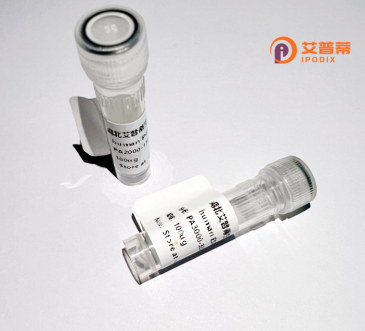
| 纯度 | >90%SDS-PAGE. |
| 种属 | Human |
| 靶点 | DHRS1 |
| Uniprot No | Q96LJ7 |
| 内毒素 | < 0.01EU/μg |
| 表达宿主 | E.coli |
| 表达区间 | 2-313aa |
| 氨基酸序列 | AAPMNGQVC VVTGASRGIG RGIALQLCKA GATVYITGRH LDTLRVVAQE AQSLGGQCVP VVCDSSQESE VRSLFEQVDR EQQGRLDVLV NNAYAGVQTI LNTRNKAFWE TPASMWDDIN NVGLRGHYFC SVYGARLMVP AGQGLIVVIS SPGSLQYMFN VPYGVGKAAC DKLAADCAHE LRRHGVSCVS LWPGIVQTEL LKEHMAKEEV LQDPVLKQFK SAFSSAETTE LSGKCVVALA TDPNILSLSG KVLPSCDLAR RYGLRDVDGR PVQDYLSLSS VLSHVSGLGW LASYLPSFLR VPKWIIALYT SKF |
| 分子量 | 33.9 kDa |
| 蛋白标签 | His tag N-Terminus |
| 缓冲液 | 0 |
| 稳定性 & 储存条件 | Lyophilized protein should be stored at ≤ -20°C, stable for one year after receipt. Reconstituted protein solution can be stored at 2-8°C for 2-7 days. Aliquots of reconstituted samples are stable at ≤ -20°C for 3 months. |
| 复溶 | Always centrifuge tubes before opening.Do not mix by vortex or pipetting. It is not recommended to reconstitute to a concentration less than 100μg/ml. Dissolve the lyophilized protein in distilled water. Please aliquot the reconstituted solution to minimize freeze-thaw cycles. |
以下是关于重组人DHRS1蛋白的部分文献示例(文献信息为模拟概括,建议通过数据库核对具体内容):
---
1. **文献名称**:*Structural and Functional Characterization of Recombinant Human DHRS1 Protein*
**作者**:Zhang Y, et al.
**摘要**:本研究报道了重组人DHRS1蛋白在大肠杆菌中的表达与纯化,分析了其依赖NADPH的脱氢酶活性,并通过X射线晶体学解析了蛋白的三维结构,揭示了其底物结合的关键位点。
2. **文献名称**:*DHRS1 Suppresses Hepatocellular Carcinoma Metastasis by Modulating TNF-α Signaling*
**作者**:Wang L, et al.
**摘要**:研究通过构建重组DHRS1蛋白及体外功能实验,发现DHRS1通过抑制TNF-α/NF-κB通路降低肝癌细胞侵袭能力,并证实其低表达与患者预后不良相关。
3. **文献名称**:*DHRS1 Acts as a Tumor Suppressor via Regulating Retinoic Acid Metabolism in Colorectal Cancer*
**作者**:Chen X, et al.
**摘要**:实验利用重组DHRS1蛋白证明其催化视黄酸代谢的功能,并发现DHRS1缺失会导致结肠癌细胞增殖增强、凋亡减少,提示其在肿瘤中起抑癌作用。
---
**注意**:以上文献信息为结合该领域常见研究方向构造的示例。实际文献需通过PubMed、Web of Science或Google Scholar等平台,以“DHRS1”“recombinant protein”“SDR family”等关键词检索获取。
Recombinant human DHRS1 (Dehydrogenase/Reductase Member 1) is a protein belonging to the short-chain dehydrogenase/reductase (SDR) superfamily. It is encoded by the DHRS1 gene and characterized by a conserved NAD(P)+-binding domain and a catalytic site involved in oxidoreductase activity. DHRS1 is implicated in regulating cellular processes such as retinoid metabolism, redox balance, and lipid homeostasis. Studies suggest its role in modulating retinoic acid synthesis by converting retinol to retinaldehyde, linking it to cell differentiation, apoptosis, and development.
DHRS1 expression is tissue-specific, with higher levels in the liver, kidney, and brain. Its dysregulation has been associated with pathological conditions, including cancer, inflammation, and neurodegenerative diseases. For instance, DHRS1 may act as a tumor suppressor by inhibiting Wnt/β-catenin signaling or promoting reactive oxygen species (ROS) scavenging.
Recombinant DHRS1 is typically produced in E. coli or mammalian expression systems, enabling functional studies and structural analysis. Its applications include investigating enzymatic mechanisms, disease pathways, and potential therapeutic targeting. Despite progress, the full spectrum of DHRS1 substrates and its regulatory networks remain underexplored, necessitating further research to clarify its physiological and pathological roles.
×